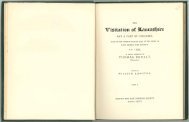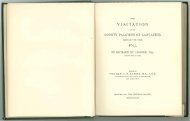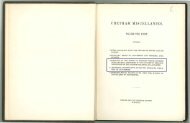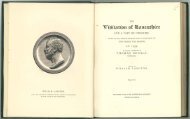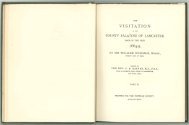Visitation of Lancashire, 1567 - John Houghton's Family History Pages
Visitation of Lancashire, 1567 - John Houghton's Family History Pages
Visitation of Lancashire, 1567 - John Houghton's Family History Pages
You also want an ePaper? Increase the reach of your titles
YUMPU automatically turns print PDFs into web optimized ePapers that Google loves.
THE<br />
VISITATION<br />
OF THE<br />
COUNTY PALATINE OF LANCASTER,<br />
MADE IN THE YEAR<br />
BY WILLIAM FLOWER, ESQ.,<br />
NORROY KING OF ARMS.<br />
EDITED BY<br />
THE REV. F. R. RAINES, M.A., F.S.A.,<br />
VICAR OF MILNROW, AND H ON. CANON<br />
OF MANCHESTER.<br />
PRINTED FOR THE CHETHAM SOCIETY.<br />
TvLDCCC.LXX.
PR I NTED BV C H AR I.E S S. S I i\]MS,<br />
l\I .\NCliESTEH,<br />
INTRODUCTION.<br />
T<br />
HE heraldic <strong>Visitation</strong> <strong>of</strong> the county palatine <strong>of</strong><br />
Lancaster in the year I 567 - thirty-four years<br />
after the last similar VIsItation - was undertaken by<br />
William Flower, esq., the N orroy king <strong>of</strong> arms,' and,<br />
contrary to the usual method, was written in the narrative<br />
form. The original MS. is preserved in the Heralds'<br />
college, but a carefully written transcript <strong>of</strong> it is in the<br />
British museum! The latter is in the handwriting <strong>of</strong><br />
Robert Glover, esq., who at the age <strong>of</strong> twenty-four was<br />
appointed Portcullis, and immediately accompanied N orroy<br />
as his marshal or deputy into <strong>Lancashire</strong>; and it has<br />
sometimes been described as "Glover's Visitati01z,"<br />
1 The following note in the MS. <strong>Visitation</strong> <strong>of</strong> <strong>Lancashire</strong>, <strong>1567</strong>, in<br />
the College <strong>of</strong> arms, is in sir William Dugdale's handwriting<br />
"<strong>Visitation</strong> <strong>of</strong> <strong>Lancashire</strong>, by -- Dalton, Norroy anno <strong>1567</strong>, 9 Elizabeth."<br />
Robert Dale, Richmond herald, has written under it "Laurence<br />
Dalton, esq., Norroy, died 13 December, 15 61, anno 4 Elizabeth.<br />
So that this annotator (sir William Dugdale) is mistaken, and this<br />
visitation was made by William Flower, esq., Norroy, Mr. Dalton's<br />
successor. Signed, Rob. Dale, B.L."<br />
2 Harl. MS., 2086.
IV btttrod14ctt'on.<br />
although according to the usage <strong>of</strong> the College <strong>of</strong> arms,<br />
N orroy alone had the power <strong>of</strong> visitation within this<br />
province, to which, however, was annexed the right <strong>of</strong><br />
appointing a deputy.<br />
Glover's MS. in the British museum forms a folio<br />
volume containing 104 pages, embracing the pedigrees<br />
<strong>of</strong> 112 families. The armorial bearings are tricked with<br />
• great artistic skill and accompany each pedigree. There<br />
are also indices <strong>of</strong> the pedigrees and ' matches, and the<br />
whole has been executed with great care from Flower's<br />
manuscript. 3<br />
Transcripts <strong>of</strong> this visitation, being coeval duplicates,<br />
exist in the libraries <strong>of</strong> Humphrey Chetham <strong>of</strong> Manchester,<br />
and <strong>of</strong> Queen's college, Oxford, and other copies, more<br />
or less inaccurate, are in several public and private<br />
collections.<br />
The Chetham library MS. was long supposed to be in<br />
the handwriting <strong>of</strong> William Smith, rouge dragon pursuivant,<br />
but this is an error. It is also erroneously described<br />
in the Catalogue <strong>of</strong> the library as "William Smith's Vz'sz'tatio1Z<br />
0./ La1zcashz're, anno 1599 ;"4 Smith having had no<br />
authority to visit the county, nor was any visitation<br />
<strong>of</strong> it held in that year. He was a native <strong>of</strong> Cheshire ,<br />
the joint author <strong>of</strong> The Vale Royal, and died in the year<br />
1618.<br />
Smith's original copy, with additional and enlarged<br />
3 Dr. Ormerod, Chetham lIfiscellan., vol. i. p. 10.<br />
4 By the Rev. <strong>John</strong> Radcliffe, vol. ii. p. 622.<br />
btttroduc NOl1-.<br />
pedigrees, is in the British museum,s and the Chetham<br />
volume seems to be an Elizabethan transcript <strong>of</strong> Smith's.<br />
I t is not a very accurate copy, as some <strong>of</strong> the pedigrees<br />
are deficient in the number <strong>of</strong> descents, some are entirely<br />
wanting, and others have been interpolated.<br />
A collation has been made <strong>of</strong> these various MSS., and<br />
in the following pages Glover's MS. is the text which<br />
has been followed, and Smith's additions and supposed<br />
emendations, whenever they occur, are included in<br />
brackets. The pedigrees not found in Glover, but<br />
which are given by Smith, include those printed on pp.<br />
12 5- 1 34. The pedigree <strong>of</strong> Whittacre (p. 13 2 ) does not<br />
relate to any <strong>Lancashire</strong> family, but may probably represent<br />
some branch claiming a remote, but not ascertained,<br />
descent from the parent stock <strong>of</strong> High Whitaker in this<br />
county.6<br />
It may also be observed that as Smith's transcript in<br />
the British museum was made in the year 1598/ and as<br />
augmentations were made to the Chetham MS. subsequent<br />
to that period, and even long after Smith's d.eath,8<br />
it is evident that the MS. <strong>of</strong> the latter has been subjected<br />
to the interpolations <strong>of</strong> some anonymous, and, it may<br />
be, not contemporaneous' genealogist. There is an old<br />
and apparently contemporaneous copy <strong>of</strong> what is called<br />
"Glover's V·z'sitati01z 0./ Yorkshz're," made in the years<br />
5 Harl. MS., 61 59. G H ist. oj WI/alley, p. 528, Add. 3 Ed.<br />
7 Maule's Bibliotlt. Heraldica, p. 582. 8 P. 13 2 .<br />
V
Vi Introduction.<br />
1584 and 1585, in the library at Knowsley,9 and although<br />
it does not include all the pedigrees recorded by Glover,<br />
it seems, as far as it extends, to be an accurate transcript,<br />
but there are found the same interpolations and subsequent<br />
additions as in the Chetham library MS., and made, not<br />
improbably, by the same hand.<br />
Dr. Pegge had a copy <strong>of</strong> Glover's <strong>Visitation</strong> oj'Derbyshire<br />
"improved by Smith," but it was not a faithful<br />
reproduction <strong>of</strong> the visiting herald. 10<br />
It is not known when this visitation <strong>of</strong> the county <strong>of</strong><br />
Lancaster commenced, how long it continued, nor where<br />
the heralds held their courts. Three hundred years ago<br />
the age <strong>of</strong> chivalry had not passed away, and a good<br />
proportion <strong>of</strong> the heads <strong>of</strong> the old feudal families answered<br />
the summons and treated the <strong>of</strong>fice <strong>of</strong> the king <strong>of</strong> arms<br />
with becoming respect. In 1533 only 47 <strong>of</strong> the county<br />
families were recognized and passed the scrutiny <strong>of</strong> the<br />
visitation, II whereas in <strong>1567</strong> we find that I 12 proved<br />
their claim to heraldic rank and gentilitial distinction.<br />
Milles, the learned antiquary, speaks <strong>of</strong> his uncle<br />
Glover's "singular method and order,"I2 and yet there<br />
seems to be a singular want <strong>of</strong> both in the arrangement<br />
<strong>of</strong> his genealogies. The pedigrees are not entered<br />
alphabetically, nor are they classified according either to<br />
the ecclesiastical or civil divisions <strong>of</strong> the county, nor has<br />
9 ellse 31, folio, pp. 82. 10 Noble's H ist. Coil. Arms, p. 248.<br />
11 Chef/tam Jjlfiscdlallies, vol. i.; Herald. Visit., p. I4.<br />
12 Gent. jJfag. , vol. xc. part i. p. 595.<br />
-<br />
hztroductimz. Vll<br />
any method been observed in their arrangement. There<br />
is' an indiscriminate enumeration <strong>of</strong> families and the<br />
earlier collaterals are generally omitted. There is also<br />
an absence <strong>of</strong> that minute information found in subsequent<br />
visitations, and which has long been considered<br />
one <strong>of</strong> the principal merits in the genealogical illustration<br />
<strong>of</strong> family succession and descent. If the heralds considered<br />
accuracy and research <strong>of</strong> importance it was<br />
necessary that they should also be so regarded by country<br />
gentlemen, many <strong>of</strong> whom in the sixteenth century, and<br />
in every other century both before and since, had no<br />
special taste for the investigation <strong>of</strong> their descent or for<br />
the elucidation <strong>of</strong> their lineage. They alone could supply<br />
authentic facts, registers and monuments, and if these<br />
were not supplied the heralds were not to blame. It is<br />
obvious however, that some contemporaneous information<br />
might have been easily obtained by these pr<strong>of</strong>essional<br />
functionaries which would have enlarged our local family<br />
knowledge, but which they failed to secure, and which is<br />
now irretrievably lost. Baptismal, nuptial, and funeral<br />
dates are all very generally omitted by them.<br />
The clergy at this time seem to have been totally indifferent<br />
about preserving the distinctions <strong>of</strong> rank, although<br />
among the many" hewers <strong>of</strong> wood and drawers <strong>of</strong> water,"<br />
each <strong>of</strong> the old families had undoubtedly given a clerk to<br />
the church. It was an age <strong>of</strong> zeal, persecution and piety,.<br />
and the more disting uished ecclesiastics, being puritans r<br />
would regard heraldry as an evidence <strong>of</strong> ostentation, and
Vlll<br />
hdrodudi07tl.<br />
would rigidly avoid "giving heed to endless genealogies,"13<br />
some <strong>of</strong> which they probably, and not unjustly, regarded<br />
as little better than "fables." We have not one clerical<br />
pedigree recorded by Flower. The clergy had evidently<br />
forgotten that there was a period in the history <strong>of</strong> the<br />
church, when the priests, who were unable to produce an<br />
exact genealogy <strong>of</strong> their ancestors, were not permitted to<br />
exercise their function,14 and it would have been a gain<br />
to local history, in many. instances, had such a rule<br />
existed in that turbulent but more privileged age <strong>of</strong> the<br />
church.<br />
At this visitation the heralds seem to have had no<br />
scruples on the subject <strong>of</strong> orthography so long as the<br />
requirements <strong>of</strong> sound were satisfied. The arbitrary<br />
variations in the mode <strong>of</strong> spelling proper names and the<br />
marvellous ingenuity in disposing <strong>of</strong> the hard-sounding<br />
names <strong>of</strong> places, have been scrupulously preserved in<br />
order that an exact copy <strong>of</strong> the visitation might be<br />
secured. And however tempting the opportunity which<br />
was sometimes presented to correct a mis-statement, to<br />
add a date, to supply an omission, or to amplify some <strong>of</strong><br />
the pedigrees, the rule wisely laid down by the President<br />
<strong>of</strong> the CHETI-IAM SOCIETY - that the heralds should be<br />
allowed to give in their own style the result <strong>of</strong> their<br />
visitation <strong>of</strong> the county - has been strictly observed, so<br />
that the remark made to an editor by a celebrated critic,<br />
will, in this instance, be spared -" Your book, sir, con-<br />
13 1 Tim. i. 4. 14 Ezra, ii. 62.<br />
Introduction. IX<br />
tains much that is new, and much that is true; but<br />
unfortunately, that which is new, is not true, and that<br />
which is true, is not new."<br />
Of these heralds a short notice may be given.<br />
vVilliam Flower was the elder son <strong>of</strong> . . . Flower <strong>of</strong> the<br />
city <strong>of</strong> York, 15 where he was born about the year 1498.<br />
His brother, Robert Flower, died on Saturday, the 5th<br />
March 1574, leaving issue one son, Peter Flower. His<br />
sister in half-blood, :Margaret Flower, married first ...<br />
Cavendish, and secondly, William Cade <strong>of</strong> Romford, the<br />
elder. Flower the N orroy married Helen, daughter <strong>of</strong><br />
... Davyes, and had issue two sons and three daughters:<br />
1. Gilbert; 2 . Edward; 3. Elizabeth, married, first, to<br />
Robert Glover, esq., Somerset herald, and, soon after his<br />
death, secondly, to Mr .. . Woolward; 4- Jane; 5. Eleanor: 6<br />
Noble, who has lately had somewhat hard measure dealt<br />
to him,17 rightly says, few have been more assiduous in<br />
the duties <strong>of</strong> their pr<strong>of</strong>ession than this N orroy. 18 He<br />
was made "Guysnes," upon the removal <strong>of</strong> Fulke ap<br />
Howell, at Westminster, 10 July, 28 Henry VII 1. 19 When<br />
Calais pursuivant extraordinary, he was sent 1st April<br />
1543 to Rouen to visit the merchants and marines who<br />
had been captured by the French, and were confined<br />
Iii There is no pedigree <strong>of</strong> Flower in the Visitatiolls <strong>of</strong> Yorkshire.<br />
16 Glover's Collectiolls, Ph. 25-1; J. C. Brooke's Collections in the-<br />
College <strong>of</strong> arms, London; Vincent's MS., 155, p. 70 b. •<br />
17 Notes alld Queries, fourth series, p. 4 27, April 30, 1870.<br />
18 H isl. Coli. Arms, p. 172.<br />
IV J. C. Brooke's Collections in Coll ege <strong>of</strong> arms; Noble's Hist., p. 13b



